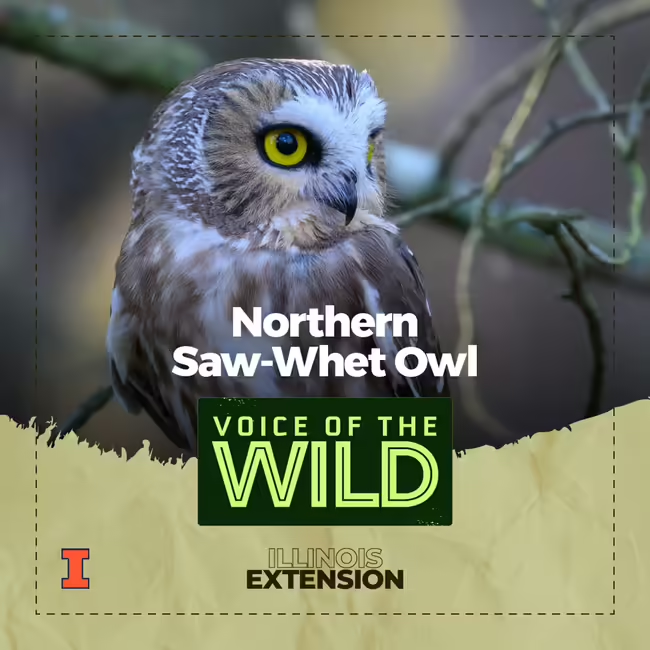
Episode Number
40
Episode Show Notes / Description
Northern saw-whet owl (Aegolius acadicus).
A cute but seldom-seen owl that visits Illinois only in fall and winter.
Do you want to learn more bird songs, frog calls, and insect noises? Join Voice of the Wild every Friday to explore a new wild voice. We’re available on most podcast platforms, including Apple Podcasts, Spotify, and YouTube.
- Subscription links Here
- Subscribe to the Newsletter
- Listen online on our Homepage
The following Cornell Lab | Macaulay Library recordings were used in this episode:
- Northern Saw-whet Owl song by Geoffrey A. Keller (ML507005)
- Northern Saw-whet Owl "skew" call by Scott Weidensaul (ML507131)
- Northern Saw-whet Owl "whine" call by Scott Weidensaul (ML507129)
Sources and more:
- https://www.youtube.com/watch?v=QT8JkWOtNto
- https://www.allaboutbirds.org/guide/Northern_Saw-whet_Owl
- https://www.audubon.org/field-guide/bird/northern-saw-whet-owl
- Dobson C, Kassenbaum D, Oehmke D, et al. 2023. Field guide to hotspots and birds in Illinois. Champaign-Urbana: Scissortail LLC.
- Peterson RT, Peterson VM. 1980. A field guide to the birds : a completely new guide to all the birds of eastern and central North America. Fourth edition, completely revised and enlarged. Boston: Houghton Mifflin Company (The Peterson field guide series ; 1).
- Sibley D. 2016. Sibley birds East : field guide to birds of eastern North America. Second edition. New York: Alfred A. Knopf (Field guide to birds of eastern North America).
Transcript
This is Illinois Extension’s Voice of the Wild. A new wild voice in just a moment, so find someplace quiet, take a deep breath, and enjoy.
This owl is very easy to overlook. I and five others, all experienced birders, two of whom were ornithologists wielding a radio antenna, once rambled in circles beneath one without seeing it.
The antenna was beeping to tell us that we were right on top of the bird’s transmitter. We nonetheless went fifteen minutes without noticing the bird directly above us. In our defense, it was in a bit of a strange place; a quarter of the way up a pine tree instead of the more typically daytime roost for the species, safely out of sight in a redcedar or thicket of honeysuckle. Typically close to the trunk and a little above eye level.
If you can find them, They’re an adorable sight, with a round head and white streaks on a tawny brown body, but don’t their cuteness fool you, though small, they are fierce; certainly the worst nightmare of wood mouse or vole.
This is the northern saw-whet owl (Aegolius acadicus) from the owl family, Strigidae
Much like the scissor-grinder cicada, the saw-whet’s name is an anachronism - the activity that secured the saw-whet name to our mutual understanding - the honing of saw teeth with a whetstone, has long since disappeared into history. Were it named now it might be called the alarm clock owl.
In illinois, we’re unlikely to hear this song as it is generally reserved for attracting mates when the bird returns to the north in the spring, but while the bird is here between October and March, we might get lucky and hear one of its other vocalizations; either their whining call or their “Skew” call.
Altogether, here’s the Northern Saw Whet Owl again.
Thank you to the Macaulay library at the Cornell lab for our bird sounds. And thank you for tuning in to learn a new wild voice with Illinois Extension.
This owl is very easy to overlook. I and five others, all experienced birders, two of whom were ornithologists wielding a radio antenna, once rambled in circles beneath one without seeing it.
The antenna was beeping to tell us that we were right on top of the bird’s transmitter. We nonetheless went fifteen minutes without noticing the bird directly above us. In our defense, it was in a bit of a strange place; a quarter of the way up a pine tree instead of the more typically daytime roost for the species, safely out of sight in a redcedar or thicket of honeysuckle. Typically close to the trunk and a little above eye level.
If you can find them, They’re an adorable sight, with a round head and white streaks on a tawny brown body, but don’t their cuteness fool you, though small, they are fierce; certainly the worst nightmare of wood mouse or vole.
This is the northern saw-whet owl (Aegolius acadicus) from the owl family, Strigidae
Much like the scissor-grinder cicada, the saw-whet’s name is an anachronism - the activity that secured the saw-whet name to our mutual understanding - the honing of saw teeth with a whetstone, has long since disappeared into history. Were it named now it might be called the alarm clock owl.
In illinois, we’re unlikely to hear this song as it is generally reserved for attracting mates when the bird returns to the north in the spring, but while the bird is here between October and March, we might get lucky and hear one of its other vocalizations; either their whining call or their “Skew” call.
Altogether, here’s the Northern Saw Whet Owl again.
Thank you to the Macaulay library at the Cornell lab for our bird sounds. And thank you for tuning in to learn a new wild voice with Illinois Extension.